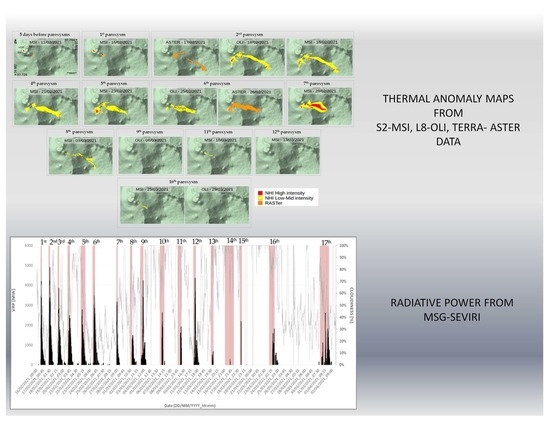Mt. Etna Paroxysms of February–April 2021 Monitored and Quantified through a Multi-Platform Satellite Observing System
Abstract
:1. Introduction
2. Mt. Etna Paroxysms of February–April 2021
3. Data
4. Methods
4.1. Hotspot Detection
4.1.1. RSTVOLC Algorithm
4.1.2. NHI Algorithm
4.2. Radiative Power Estimation
4.2.1. AVHRR Estimations
4.2.2. SEVIRI and MODIS Estimations
5. Results
5.1. Thermal Anomaly Identification and Mapping
5.2. Monitoring and Quantifying Mt. Etna Paroxysms
5.2.1. AVHRR and MODIS Observations
5.2.2. SEVIRI Observations
6. Discussion
7. Conclusions
Author Contributions
Funding
Data Availability Statement
Acknowledgments
Conflicts of Interest
Appendix A
| Date of the Paroxysmal Event | Start and End Times | Eruption Features |
|---|---|---|
| 1st (16 Feb) | 17:05–18:00 UTC | Lava fountains (duration 45 min; 500–600 m high), eruptive column (10 km a.s.l.), lava and pyroclastic flows moving towards Valle del Bove and Valle del Leone. |
| 2nd (17–18 Feb) | 22:30–00:40 UTC | Lava fountains (duration 35 min; 600–700 m high), eruptive column and ash impact on the ESE sector, lava flow moving towards NE, SE (Valle del Bove) and SW (southern flank). |
| 3rd (19 Feb) | 07:55–10:10 UTC | Lava fountains from 4–5 vents (duration 65 min; 600–700 m high), eruptive column (10 km a.s.l.), ash impact on the SE sector, lava flows towards E (Valle del Bove) and SW (southern flank), hydromagmatic explosions (lava–snow interaction). |
| 4th (20–21 Feb) | 20:00–01:20 UTC | Lava fountains (duration 180 min, up to 1000 m high), eruptive column (10 km a.s.l.), ash impact on the SW sector, small (in length and volume) lava flows towards E (Valle del Bove) and SW (southern flank). |
| 5th (22–23 Feb) | 20:30–10:38 UTC | Lava fountains (duration 50 min), Strombolian activity and lava overflow, eruptive column (more than 10 km a.s.l.), ash impact on the NW sector. |
| 6th (24 Feb) | 16:00–22:20 UTC | Lava fountains (duration 140 min; 500 m high), eruptive column (11 km a.s.l.), lava flows towards E (Valle del Bove) and SW (southern flank). |
| 7th (28 Feb) | 08:10–09:33 UTC | Lava fountains (duration 54 min; 700 m high), eruptive column (11 km a.s.l.), ash impact on the E sector, lava flows towards E (Valle del Bove). |
| 8th (2 March) | 10:45–14:50 UTC | Lava fountains (duration 120 min), eruptive column (beyond clouds, up to 9 km a.s.l), ash impact on the S sector. |
| 9th (4 March) | 00:20–08:30 UTC | Lava fountains (duration 130 min; 300 m high), eruptive column (11 km a.s.l.), ash impact on the NE sector, small lava flow, Strombolian activity at Voragine Crater. |
| 10th (7 March) | 00:00–14:00 UTC | Lava fountains (duration 60 min), eruptive column (10 km a.s.l.), ash impact on the E sector, lava flows towards E (Valle del Bove, down to 2700 m a.s.l.). |
| 11th (9–10 March) | 18:00–03:30 UTC | Lava fountains (duration 163 min; 500 m high), eruptive column (up to 9–10 km a.s.l.), ash impact on the E sector, lava flows towards E (Valle del Bove, down to 1770 m a.s.l.), discontinuous Strombolian activity persists even after the end of the paroxysm, until the next one. |
| 12th (12 March) | 03:20–10:00 UTC | Lava fountains (duration 175 min; 500 m), eruptive column (up to 9–10 km a.s.l.), ash impact on the E sector, lava flows towards E (Valle del Bove), discontinuous Strombolian activity persists even after the end of the paroxysm, until the next one. |
| 13th (14–15 March) | 20:10–02:50 UTC | Lava fountains (duration 170 min), eruptive column and ash impact on the E sector, lava flows towards E (Valle del Bove) and S (southern flank), discontinuous Strombolian activity persists even after the end of the paroxysm, until the next one. |
| 14th (17–18 March) | 00:30–06:00 UTC | Lava fountains (duration 170 min), eruptive column and ash impact on the SE sector, lava flows towards E (Valle del Bove, down to 2200 m a.s.l.), Strombolian activity persists even after the end of the paroxysm, until the next one. |
| 15th (19 March) | 06:34–11:20 UTC | Lava fountain (duration 120 min), eruptive column and ash impact on the ESE sector, lava flows towards E (Valle del Bove), Strombolian activity persists even after the end of the paroxysm, until the next one. |
| 16th (23–24 March) | 19:05–11:55 UTC | Lava fountains, (duration 480 min), eruptive column (up to 6–7 km a.s.l.), ash impact on the SSO-SE sector, lava flows towards E (Valle del Bove) and S (southern flank), Strombolian activity and discontinuous lava effusions persist after the end of the paroxysm, until the next one. |
| 17th (31 March– 1 April) | 14:30–21:00 UTC | The paroxysm was preceded by an intense Strombolian activity occurring on March 30th. Lava fountains, (time duration 540 min), eruptive column (9–10 km a.s.l.), ash impact on the SSW sector, lava flows towards E, SE, SSE (Valle de Bove) and S, SW (southern flank) up to 3.3 km long down to 1820 m a.s.l. |
References
- Higgins, J.; Harris, A. VAST: A program to locate and analyse volcanic thermal anomalies automatically from remotely sensed data. Comput. Geosci. 1997, 23, 627–645. [Google Scholar] [CrossRef]
- Dean, K.; Servilla, M.; Roach, A.; Foster, B.; Engle, K. Satellite monitoring of remote volcanoes improves study efforts in Alaska. Eos Trans. AGU 1998, 79, 413–423. [Google Scholar] [CrossRef]
- Wright, R.; Flynn, L.; Garbeil, H.; Harris, A.; Pilger, E. Automated volcanic eruption detection using MODIS. Remote Sens. Environ. 2002, 82, 135–155. [Google Scholar] [CrossRef] [Green Version]
- Pergola, N.; Marchese, F.; Tramutoli, V. Automated detection of thermal features of active volcanoes by means of infrared AVHRR records. Remote Sens. Environ. 2004, 93, 311–327. [Google Scholar] [CrossRef]
- Pergola, N.; Marchese, F.; Tramutoli, V.; Filizzola, C.; Ciampa, M. Advanced satellite technique for volcanic activity monitoring and early warning. Ann. Geophys. 2008, 51. [Google Scholar] [CrossRef]
- Hirn, B.; Di Bartola, C.; Ferrucci, F. Combined use of SEVIRI and MODIS for detecting, measuring, and monitoring active lava flows at erupting volcanoes. IEEE Trans. Geosci. Remote Sens. 2009, 47, 2923–2930. [Google Scholar] [CrossRef]
- Gouhier, M.; Harris, A.; Calvari, S.; Labazuy, P.; Guéhenneux, Y.; Donnadieu, F.; Valade, S. Lava discharge during Etna's January 2011 fire fountain tracked using MSG-SEVIRI. Bull. Volcanol. 2012, 74, 787–793. [Google Scholar] [CrossRef]
- Coppola, D.; Laiolo, M.; Massimetti, F.; Cigolini, C. Monitoring endogenous growth of open-vent volcanoes by balancing thermal and SO2 emissions data derived from space. Sci. Rep. 2019, 9, 1–12. [Google Scholar] [CrossRef] [Green Version]
- Tsutsumi, R.; Hattori, K.; Yoshino, C.; Genzano, N. Detection of Thermal Changes Related to the 2011 Shinmoedake Volcano Activity and Japan: Spatiotemporal Variation of Singularity of MODIS Data after Discriminating False Changes Due to Cloud. Remote Sens. 2020, 12, 2637. [Google Scholar] [CrossRef]
- Coppola, D.; Piscopo, D.; Laiolo, M.; Cigolini, C.; Delle Donne, D.; Ripepe, M. Radiative heat power at Stromboli volcano during 2000–2011: Twelve years of MODIS observations. J. Volcanol. Geotherm. Res. 2012, 215, 48–60. [Google Scholar] [CrossRef] [Green Version]
- Marchese, F.; Lacava, T.; Pergola, N.; Hattori, K.; Miraglia, E.; Tramutoli, V. Inferring phases of thermal unrest at Mt. Asama (Japan) from infrared satellite observations. J. Volcanol. Geotherm. Res. 2012, 237, 10–18. [Google Scholar] [CrossRef]
- Calvari, S.; Bilotta, G.; Bonaccorso, A.; Caltabiano, T.; Cappello, A.; Corradino, C.; Del Negro, C.; Ganci, G.; Neri, M.; Pecora, E.; et al. The VEI 2 Christmas 2018 Etna Eruption: A Small But Intense Eruptive Event or the Starting Phase of a Larger One? Remote Sens. 2020, 12, 905. [Google Scholar] [CrossRef] [Green Version]
- Murphy, S.W.; Wright, R.; Oppenheimer, C.; Souza Filho, C.R. MODIS and ASTER synergy for characterizing thermal volcanic activity. Remote Sens. Environ. 2013, 131, 195–205. [Google Scholar] [CrossRef]
- Ramsey, M.S. Synergistic use of Satellite Thermal Detection and Science: A Decadal Perspective using ASTER. In Detecting, Modelling and Responding to Effusive Eruptions; Harris, A., De Groeve, T., Garel, F., Carn, S., Eds.; Geological Society of London: London, UK, 2016; pp. 115–136. [Google Scholar] [CrossRef] [Green Version]
- Ramsey, M.S.; Flynn, I.T. The spatial and spectral resolution of ASTER infrared image data: A paradigm shift in volcanological remote sensing. Remote Sens. 2020, 12, 738. [Google Scholar] [CrossRef] [Green Version]
- Flower, V.J.; Kahn, R.A. Twenty years of NASA-EOS multi-sensor satellite observations at Kīlauea volcano (2000–2019). J. Volcanol. Geotherm. Res. 2021, 415, 107247. [Google Scholar] [CrossRef]
- Marchese, F.; Neri, M.; Falconieri, A.; Lacava, T.; Mazzeo, G.; Pergola, N.; Tramutoli, V. The contribution of multi-sensor infrared satellite observations to monitor Mt. Etna (Italy) activity during May to August 2016. Remote Sens. 2018, 10, 1948. [Google Scholar] [CrossRef] [Green Version]
- Massimetti, F.; Diego, C.; Marco, L.; Sébastien, V.; Cigolini, C.; Ripepe, M. Volcanic Hot-Spot Detection Using SENTINEL-2: A Comparison with MODIS–MIROVA Thermal Data Series. Remote Sens. 2020, 12, 820. [Google Scholar] [CrossRef] [Green Version]
- Plank, S.; Marchese, F.; Genzano, N.; Nolde, M.; Martinis, S. The short life of the volcanic island New Late’iki (Tonga) analyzed by multi-sensor remote sensing data. Sci. Rep. 2020, 10, 1–15. [Google Scholar] [CrossRef]
- Plank, S.; Massimetti, F.; Soldati, A.; Hess, K.U.; Nolde, M.; Martinis, S.; Dingwell, D.B. Estimates of lava discharge rate of 2018 Kīlauea Volcano, Hawaiʻi eruption using multi-sensor satellite and laboratory measurements. Int. J. Remote Sens. 2021, 42, 1492–1511. [Google Scholar] [CrossRef]
- Acocella, V.; Neri, M. What makes flank eruptions? The 2001 Etna eruption and its possible triggering mechanisms. Bull. Volcanol. 2003, 65, 517–529. [Google Scholar] [CrossRef]
- Neri, M.; Acocella, V.; Behncke, B.; Giammanco, S.; Mazzarini, F.; Rust, D. Structural analysis of the eruptive fissures at Mount Etna (Italy). Ann. Geophys. 2011, 54. [Google Scholar] [CrossRef]
- Del Negro, C.; Cappello, A.; Neri, M.; Bilotta, G.; Hérault, A.; Ganci, G. Lava flow hazards at Mount Etna: Constraints imposed by eruptive history and numerical simulations. Sci. Rep. 2013, 3, 3493. [Google Scholar] [CrossRef] [Green Version]
- De Beni, E.; Cantarero, M.; Neri, M.; Messina, A. Lava flows of Mt Etna, Italy: The 2019 eruption within the context of the last two decades (1999–2019). J. Maps 2020. [Google Scholar] [CrossRef]
- Global Volcanism Program, Bulletin of the Global Volcanism Network, Report on Etna (Italy); Smithsonian Institution: Washington, DC, USA, 2013. [CrossRef]
- Behncke, B.; Neri, M.; Pecora, E.; Zanon, V. The exceptional activity and growth of the Southeast Crater, Mount Etna (Italy), between 1996 and 2001. Bull. Volcanol. 2006, 69, 149–173. [Google Scholar] [CrossRef]
- De Beni, E.; Behncke, B.; Branca, S.; Nicolosi, I.; Carluccio, R.; Caracciolo, F.A.; Chiappini, M. The continuing story of Etna's New Southeast Crater (2012–2014): Evolution and volume calculations based on field surveys and aerophotogrammetry. J. Volcanol. Geotherm. Res. 2015, 303, 175–186. [Google Scholar] [CrossRef]
- Giuffrida, M.; Viccaro, M. Three years (2011–2013) of eruptive activity at Mt. Etna: Working modes and timescales of the modern volcano plumbing system from micro-analytical studies of crystals. Earth-Sci. Rev. 2017, 171, 289–322. [Google Scholar] [CrossRef]
- Corsaro, R.A.; Andronico, D.; Behncke, B.; Branca, S.; Caltabiano, T.; Ciancitto, F.; Cristaldi, A.; De Beni, E.; La Spina, A.; Lodato, L.; et al. Monitoring the December 2015 summit eruptions of Mt. Etna (Italy): Implications on eruptive dynamics. J. Volcanol. Geotherm. Res. 2017, 341, 53–69. [Google Scholar] [CrossRef]
- Istituto Nazionale di Geofisica e Vulcanologia. Bollettino Settimanale Etna, 15/02/2021–21/02/2021. Publication Date: 23/02/2021. Available online: https://www.ct.ingv.it/index.php/monitoraggio-e-sorveglianza/prodotti-del-monitoraggio/bollettini-settimanali-multidisciplinari/473-bollettino-settimanale-sul-monitoraggio-vulcanico-geochimico-e-sismico-del-vulcano-etna20210223/file (accessed on 23 June 2021). (In Italian).
- Pergola, N.; Coviello, I.; Filizzola, C.; Lacava, T.; Marchese, F.; Paciello, R.; Tramutoli, V. A Review of RSTVOLC, An Original Algorithm for Automatic Detection and Near-Real-Time Monitoring of Volcanic Hotspots from Space. In Detecting, Modelling and Responding to Effusive Eruptions; Harris, A., De Groeve, T., Garel, F., Carn, S., Eds.; Geological Society of London: London, UK, 2016; pp. 55–72. [Google Scholar] [CrossRef]
- Genzano, N.; Marchese, F.; Neri, M.; Pergola, N.; Tramutoli, V. Implementation of Robust Satellite Techniques for Volcanoes on ASTER Data under the Google Earth Engine Platform. Appl. Sci. 2021, 11, 4201. [Google Scholar] [CrossRef]
- Genzano, N.; Pergola, N.; Marchese, F. A Google Earth Engine tool to investigate, map and monitor volcanic thermal anomalies at global scale by means of mid-high spatial resolution satellite data. Remote Sens. 2020, 12, 3232. [Google Scholar] [CrossRef]
- Neri, M.; Rivalta, E.; Maccaferri, F.; Acocella, V.; Cirrincione, R. Etnean and Hyblean volcanism shifted away from the Malta Escarpment by crustal stresses. Earth Planet Sci. Lett. 2018, 486, 15–22. [Google Scholar] [CrossRef] [Green Version]
- Corsaro, R.; Miraglia, L. Lapilli e ceneri: Il magma primitivo dell’Etna non ha segreti. Blog INGVvulcani 2021. Available online: https://ingvvulcani.com/2021/02/22/lapilli-e-ceneri-il-magma-primitivo-delletna-non-ha-segreti/ (accessed on 23 June 2021). (In Italian).
- European Space Agency. About AVHRR/3. Available online: http://www.esa.int/Applications/Observing_the_Earth/Meteorological_missions/MetOp/About_AVHRR_3 (accessed on 23 June 2021).
- Schmid, J. The SEVIRI Instrument. 2000. Available online: https://www-cdn.eumetsat.int/files/2020-04/pdf_ten_msg_seviri_instrument.pdf (accessed on 23 June 2021).
- Roy, D.P.; Kovalskyy, V.; Zhang, H.K.; Vermote, E.F.; Yan, L.; Kumar, S.S.; Egorov, A. Characterization of Landsat-7 to Landsat-8 reflective wavelength and normalized difference vegetation index continuity. Remote Sens. Environ. 2016, 185, 57–70. [Google Scholar] [CrossRef] [PubMed] [Green Version]
- Martimort, P.; Fernandez, V.; Kirschner, V.; Isola, C.; Meygret, A. Sentinel-2 MultiSpectral imager (MSI) and calibration/validation. In Proceedings of the IEEE International Geoscience and Remote Sensing Symposium, Munich, Germany, 22–27 July 2012; pp. 6999–7002. [Google Scholar] [CrossRef]
- Marchese, F.; Filizzola, C.; Genzano, N.; Mazzeo, G.; Pergola, N.; Tramutoli, V. Assessment and improvement of a robust satellite technique (RST) for thermal monitoring of volcanoes. Remote Sens. Environ. 2011, 115, 1556–1563. [Google Scholar] [CrossRef]
- Tramutoli, V. Robust satellite techniques (RST) for natural and environmental hazards monitoring and mitigation: Theory and applications. In Proceedings of the International Workshop on the Analysis of Multi-temporal Remote Sensing Images, Leuven, Belgium, 18–20 July 2007. [Google Scholar] [CrossRef]
- Cuomo, V.; Filizzola, C.; Pergola, N.; Pietrapertosa, C.; Tramutoli, V. A self-sufficient approach for GERB cloudy radiance detection. Atmos. Res. 2004, 72, 39–56. [Google Scholar] [CrossRef]
- Filizzola, C.; Corrado, R.; Marchese, F.; Mazzeo, G.; Paciello, R.; Pergola, N.; Tramutoli, V. RST-FIRES, an exportable algorithm for early-fire detection and monitoring: Description, implementation, and field validation in the case of the MSG-SEVIRI sensor. Remote Sens. Environ. 2017, 192, e2–e25. [Google Scholar] [CrossRef]
- Marchese, F.; Genzano, N.; Neri, M.; Falconieri, A.; Mazzeo, G.; Pergola, N. A Multi-channel algorithm for mapping volcanic thermal anomalies by means of Sentinel-2 MSI and Landsat-8 OLI data. Remote Sens. 2019, 11, 2876. [Google Scholar] [CrossRef] [Green Version]
- Mazzeo, G.; Ramsey, M.S.; Marchese, F.; Genzano, N.; Pergola, N. Implementation of the NHI (Normalized Hot Spot Indices) Algorithm on Infrared ASTER Data: Results and Future Perspectives. Sensors 2021, 21, 1538. [Google Scholar] [CrossRef]
- National Aeronautics and Space Administration, Jet Propulsion Laboratory, ASTER–Advanced Spaceborne Thermal Emission and Reflection Radiometer. Available online: https://asterweb.jpl.nasa.gov/swir-alert.asp (accessed on 23 June 2021).
- Liu, Y.; Zhi, W.; Xu, B.; Xu, W.; Wu, W. Detecting high-temperature thermal anomalies from Sentinel-2 MSI images. ISPRS J. Photogramm. Remote Sens. 2021, 177, 174–193. [Google Scholar] [CrossRef]
- Harris, A.J.; Blake, S.; Rothery, D.A.; Stevens, N.F. A chronology of the 1991 to 1993 Mount Etna eruption using advanced very high resolution radiometer data: Implications for realtime thermal volcano monitoring. J. Geophys. Res. Solid Earth 1997, 102, 7985–8003. [Google Scholar] [CrossRef]
- Piscini, A.; Lombardo, V. Volcanic hot spot detection from optical multispectral remote sensing data using artificial neural networks. Geophys. J. Int. 2014, 196, 1525–1535. [Google Scholar] [CrossRef] [Green Version]
- Buongiorno, M.F.; Realmuto, V.J.; Doumaz, F. Recovery of spectral emissivity from thermal infrared multispectral scanner imagery acquired over a mountainous terrain: A case study from Mount Etna Sicily. Remote Sens. Environ. 2002, 79, 123–133. [Google Scholar] [CrossRef]
- Wooster, M.J.; Zhukov, B.; Oertel, D. Fire radiative energy for quantitative study of biomass burning from the BIRD experimental satellite and comparison to MODIS fire products. Remote Sens. Environ. 2003, 86, 83–107. [Google Scholar] [CrossRef]
- Wooster, M.J.; Roberts, G.; Perry, G.L.W.; Kaufman, Y.J. Retrieval of biomass combustion rates and totals from fire radiative power observations: FRP derivation and calibration relationships between biomass consumption and fire radiative energy release. J. Geophys. Res. 2005, 110. [Google Scholar] [CrossRef]
- Li, F.; Zhang, X.; Kondragunta, S.; Csiszar, I. Comparison of fire radiative power estimates from VIIRS and MODIS observations. J. Geophys. Res. Atmos. 2018, 123, 4545–4563. [Google Scholar] [CrossRef]
- Giglio, L.; Schroeder, W.; Hall, J.V.; Justice, C.O. MODIS Collection 6 Active Fire Product User’s Guide, Revision B. 2018. Available online: https://modis-fire.umd.edu/files/MODIS_C6_Fire_User_Guide_B.pdf (accessed on 23 June 2021).
- Giglio, L.; Schroeder, W.; Justice, C.O. The collection 6 MODIS active fire detection algorithm and fire products. Remote Sens. Environ. 2016, 178, 31–41. [Google Scholar] [CrossRef] [Green Version]
- Coppola, D.; Laiolo, M.; Cigolini, C.; Massimetti, F.; Delle Donne, D.; Ripepe, M.; Arias, H.; Barsotti, S.; Bucarey Parra, C.; Centeno, R.G.; et al. Thermal remote sensing for global volcano monitoring: Experiences from the MIROVA system. Front. Earth Sci. 2020, 7, 362. [Google Scholar] [CrossRef] [Green Version]
- Global Volcanism Program. Report on Etna (Italy). Weekly Volcanic Activity Report; Sennert, S.K., Ed.; Smithsonian Institution and US Geological Survey: Washington, DC, USA 17–23 February 2021. Available online: https://volcano.si.edu/showreport.cfm?doi=GVP.WVAR20210217-211060 (accessed on 23 June 2021).
- Istituto Nazionale di Geofisica e Vulcanologia. Bollettino Settimanale Etna, 22/02/2021–28/02/2021. Publication Date: 02/03/2021. Available online: https://www.ct.ingv.it/index.php/monitoraggio-e-sorveglianza/prodotti-del-monitoraggio/bollettini-settimanali-multidisciplinari/474-bollettino-settimanale-sul-monitoraggio-vulcanico-geochimico-e-sismico-del-vulcano-etna20210302/file (accessed on 23 June 2021). (In Italian).
- Istituto Nazionale di Geofisica e Vulcanologia. Bollettino Settimanale Etna, 01/03/2021–07/03/2021. Publication Date: 09/03/2021. Available online: https://www.ct.ingv.it/index.php/monitoraggio-e-sorveglianza/prodotti-del-monitoraggio/bollettini-settimanali-multidisciplinari/476-bollettino-settimanale-sul-monitoraggio-vulcanico-geochimico-e-sismico-del-vulcano-etna20210309/file (accessed on 23 June 2021). (In Italian).
- Istituto Nazionale di Geofisica e Vulcanologia. Etna, 9–10 Marzo 2021. Undicesimo Parossismo del Vulcano. Available online: https://www.ingv.it/it/stampa-e-urp/stampa/comunicati-stampa/4784-etna-9-10-marzo-2021-undicesimo-parossismo-del-vulcano (accessed on 23 June 2021). (In Italian).
- Istituto Nazionale di Geofisica e Vulcanologia. Etna, 12 Marzo 2021. Dodicesimo Parossismo del Vulcano. Available online: https://www.ingv.it/it/stampa-e-urp/stampa/comunicati-stampa/4786-etna-12-marzo-2021-dodicesimo-parossismo-del-vulcano (accessed on 23 June 2021). (In Italian).
- Global Volcanism Program. Report on Etna (Italy). Weekly Volcanic Activity Report; Sennert, S.K., Ed.; Smithsonian Institution and US Geological Survey: Washington, DC, USA 17–23 February 2021. Available online: https://volcano.si.edu/showreport.cfm?doi=GVP.WVAR20210317-211060 (accessed on 23 June 2021).
- Istituto Nazionale Geofisica e Vulcanologia. Etna, 23–24 Marzo 2021. Sedicesimo Parossismo al Cratere di Sud-Est. Available online: https://ingvvulcani.com/2021/03/24/etna-23-24-marzo-2021-sedicesimo-parossismo-al-cratere-di-sud-est/ (accessed on 23 June 2021). (In Italian).
- Global Volcanism Program. Report on Etna (Italy). Weekly Volcanic Activity Report; Sennert, S.K., Ed.; Smithsonian Institution and US Geological Survey: Washington, DC, USA 31 March 2021–6 April 2021. Available online: https://volcano.si.edu/showreport.cfm?doi=GVP.WVAR20210331-211060 (accessed on 23 June 2021).
- Istituto Nazionale di Geofisica e Vulcanologia. Bollettino settimanale Etna, 15/03/2021–21/03/2021. Publication date: 23/03/2021. Available online: https://www.ct.ingv.it/index.php/monitoraggio-e-sorveglianza/prodotti-del-monitoraggio/bollettini-settimanali-multidisciplinari/480-bollettino-settimanale-sul-monitoraggio-vulcanico-geochimico-e-sismico-del-vulcano-etna20210323/file (accessed on 23 June 2021). (In Italian).
- Volcano Discovery. Etna Volcano–Eruption Update. Available online: https://www.volcanodiscovery.com/etna/current-activity.html (accessed on 23 June 2021).
- Istituto Nazionale di Geofisica e Vulcanologia. Etna 19 Marzo 2021, il Quindicesimo Parossismo in un Mese. Available online: https://ingvvulcani.com/2021/03/19/etna-19-marzo-2021-il-quindicesimo-parossismo-in-un-mese/ (accessed on 23 June 2021). (In Italian).
- Behncke, B. Etna parossismo al cratere di Sud Est nel giorno di Santa Lucia. Blog INGVvulcani 2020. Available online: https://ingvvulcani.com/2020/12/15/etna-parossismo-al-cratere-di-sud-est-nel-giorno-di-santa-lucia/ (accessed on 23 June 2021).
- Ganci, G.; Cappello, A.; Bilotta, G.; Herault, A.; Zago, V.; Del Negro, C. Mapping volcanic deposits of the 2011–2015 Etna eruptive events using satellite remote sensing. Front. Earth Sci. 2018, 6, 83. [Google Scholar] [CrossRef]
- Coppola, D.; James, M.R.; Staudacher, T.; Cigolini, C. A comparison of field-and satellite-derived thermal flux at Piton de la Fournaise: Implications for the calculation of lava discharge rate. Bull. Volcanol. 2010, 72, 341–356. [Google Scholar] [CrossRef]
- Harris, A.; De Groeve, T.; Garel, F.; Carn, S. Detecting, Modelling and Responding to Effusive Eruptions; Geological Society of London: London, UK, 2016; p. 426. [Google Scholar] [CrossRef]
- Wooster, M.J.; Roberts, G.; Freeborn, P.H.; Xu, W.; Govaerts, Y.; Beeby, R.; He, J.; Lattanzio, A.; Fisher, D.; Mullen, R. LSA SAF meteosat FRP products—Part 1: Algorithms, product contents and analysis. Atmos. Chem. Phys. 2015, 15, 13217–13239. [Google Scholar] [CrossRef] [Green Version]
- Barnie, T.; Oppenheimer, C. Extracting High Temperature Event radiance from satellite images and correcting for saturation using Independent Component Analysis. Remote Sens. Environ. 2015, 158, 56–68. [Google Scholar] [CrossRef] [Green Version]
- De Novellis, V.; Atzori, S.; De Luca, C.; Manzo, M.; Valerio, E.; Bonano, M.; Cardaci, C.; Castaldo, R.; Di Bucci, D.; Manunta, M.; et al. DInSAR analysis and analytical modeling of Mount Etna displacements: The December 2018 volcano-tectonic crisis. Geophys. Res. Lett. 2019, 46, 5817–5827. [Google Scholar] [CrossRef] [Green Version]
- Allard, P.; Behncke, B.; D’Amico, S.; Neri, M.; Gambino, S. Mount Etna 1993–2005: Anatomy of an Evolving Eruptive Cycle. Earth-Sci. Rev. 2006, 78, 85–114. [Google Scholar] [CrossRef]
- Neri, M.; Casu, F.; Acocella, V.; Solaro, G.; Pepe, S.; Berardino, P.; Sansosti, E.; Caltabiano, T.; Lundgren, P.; Lanari, R. Deformation and eruptions at Mt. Etna (Italy): A lesson from 15 years of observations. Geophys. Res. Lett. 2009, 36, L02309. [Google Scholar] [CrossRef]
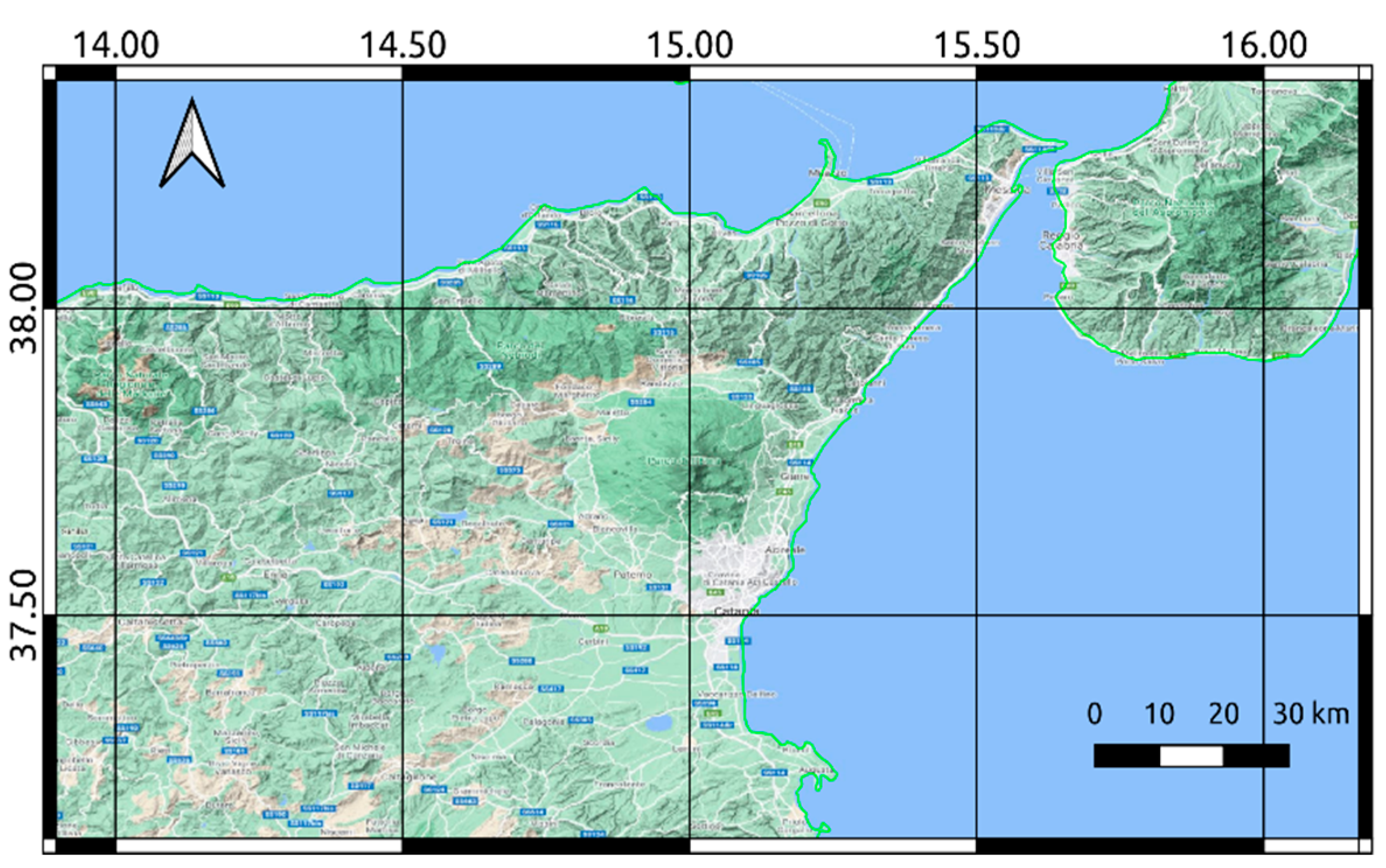
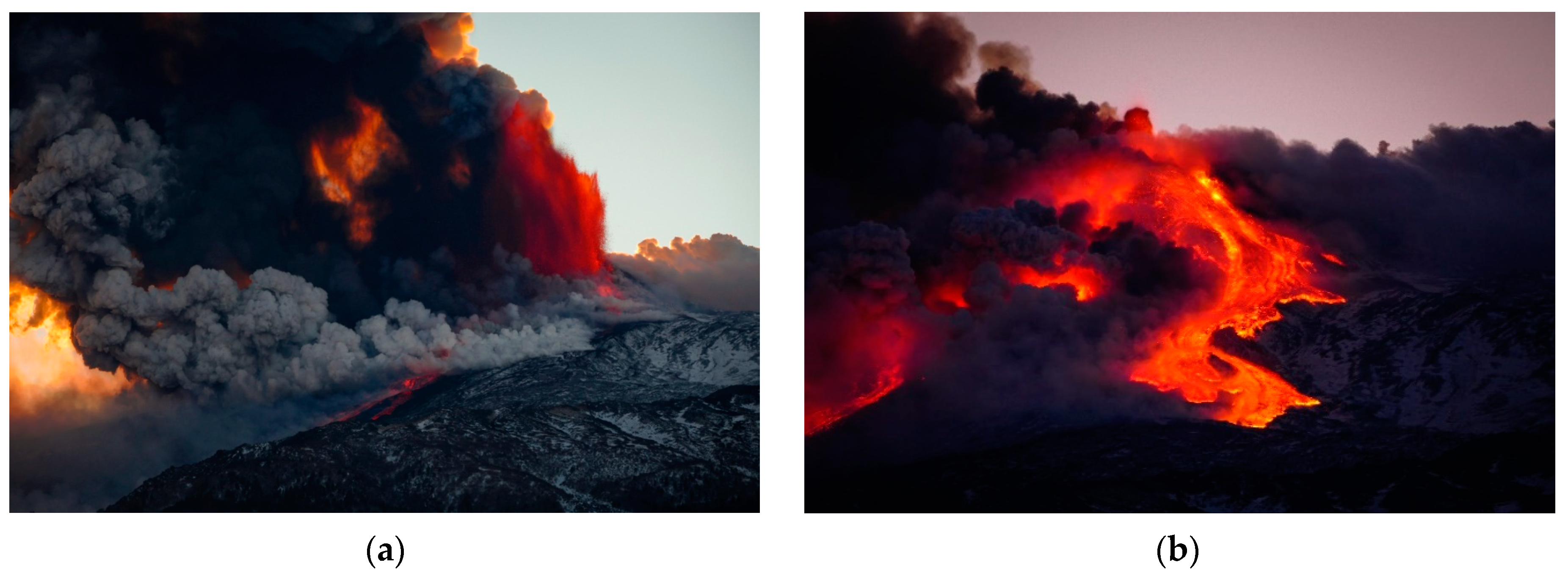
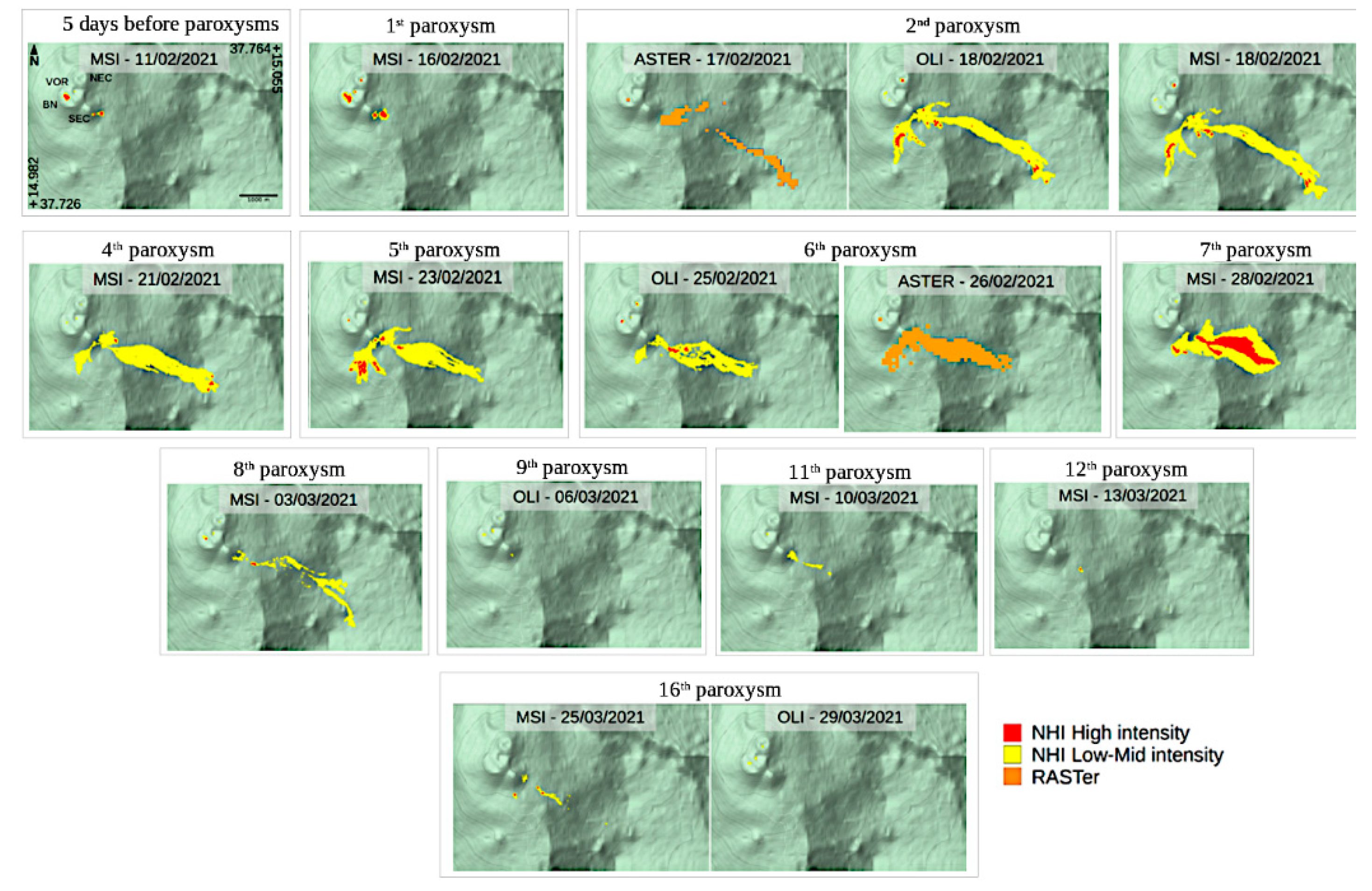
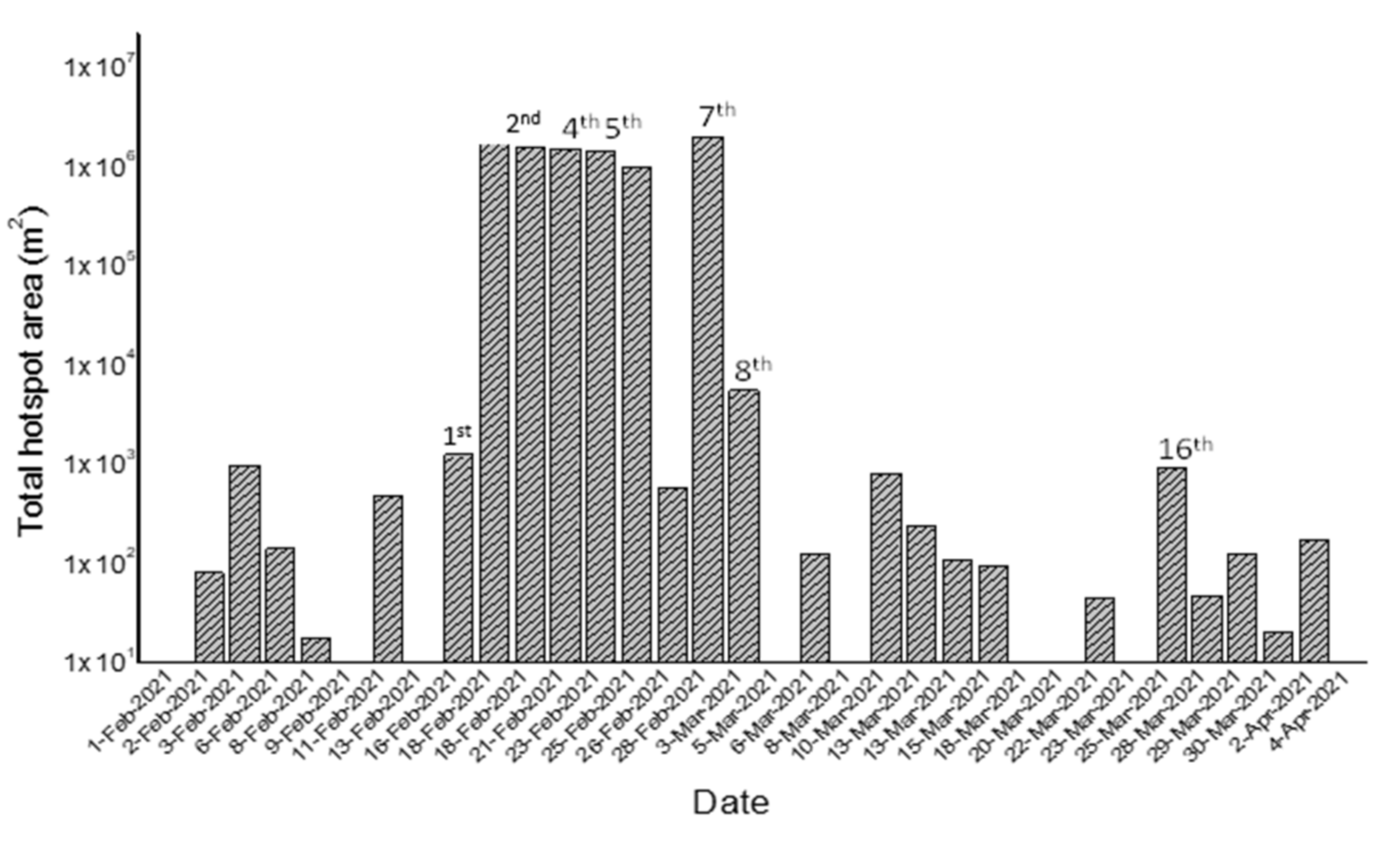

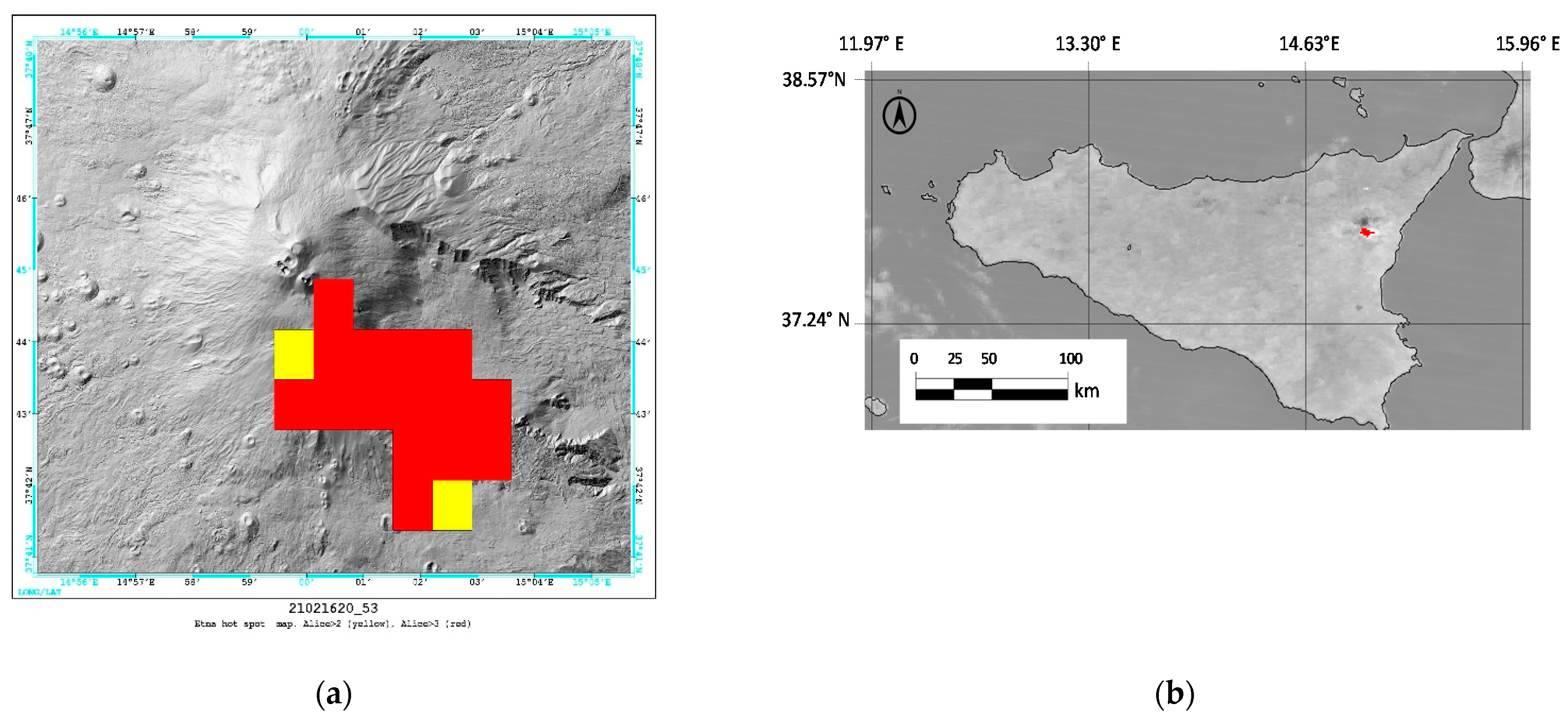
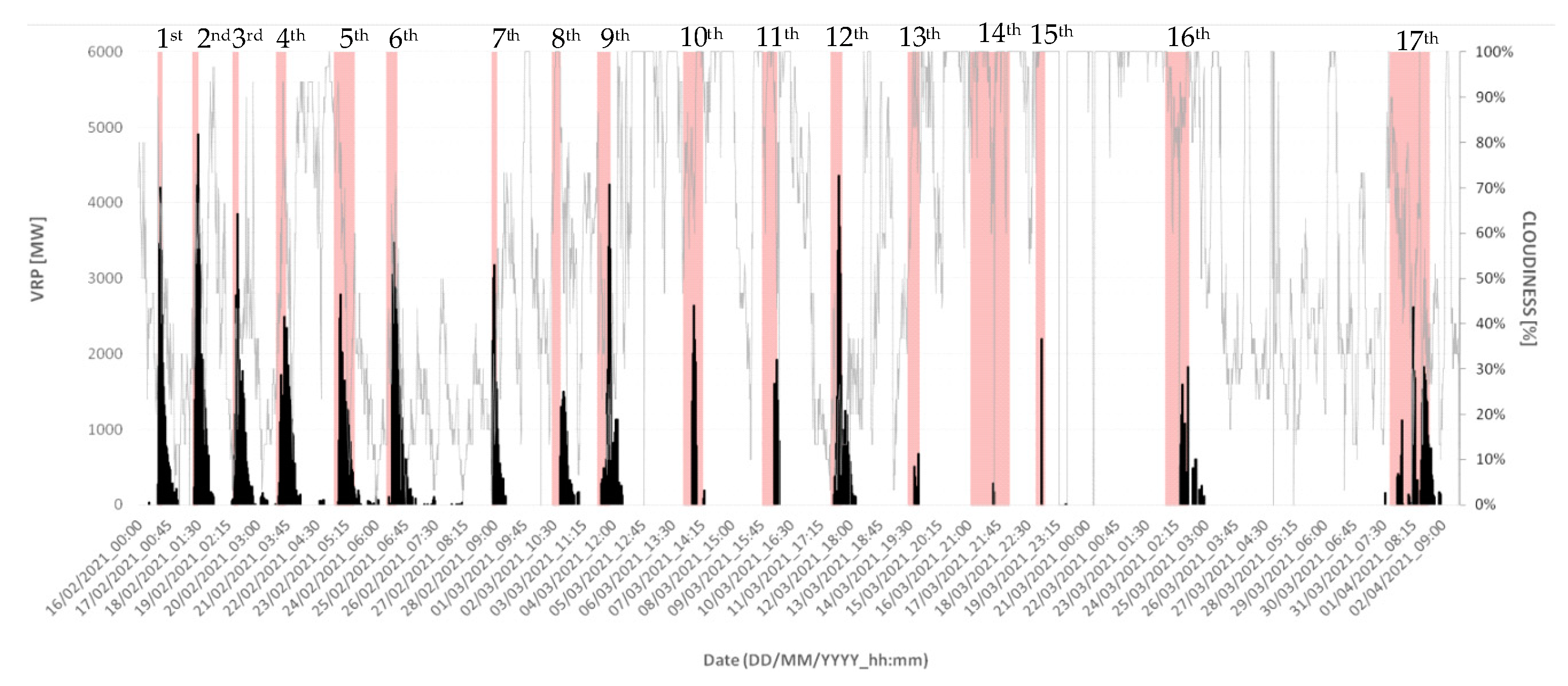
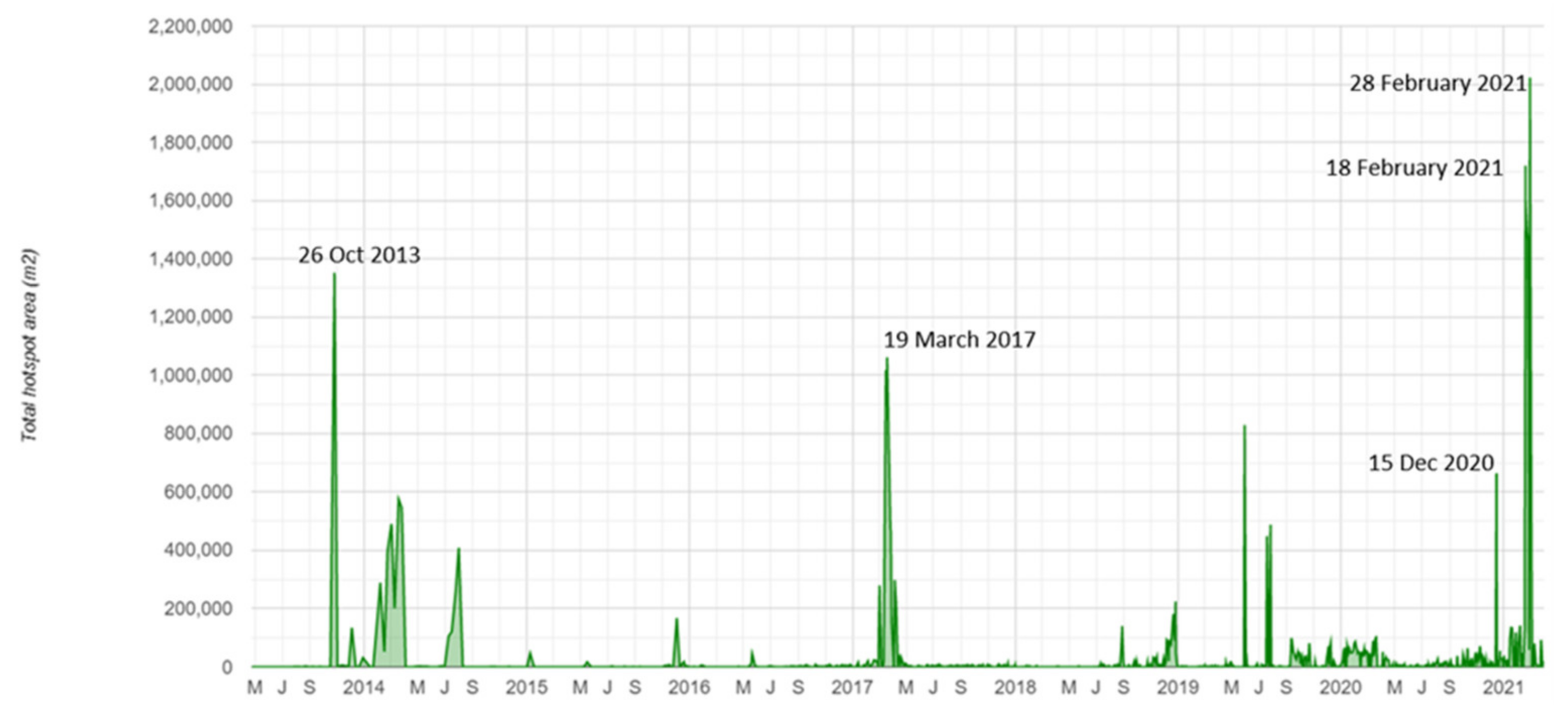
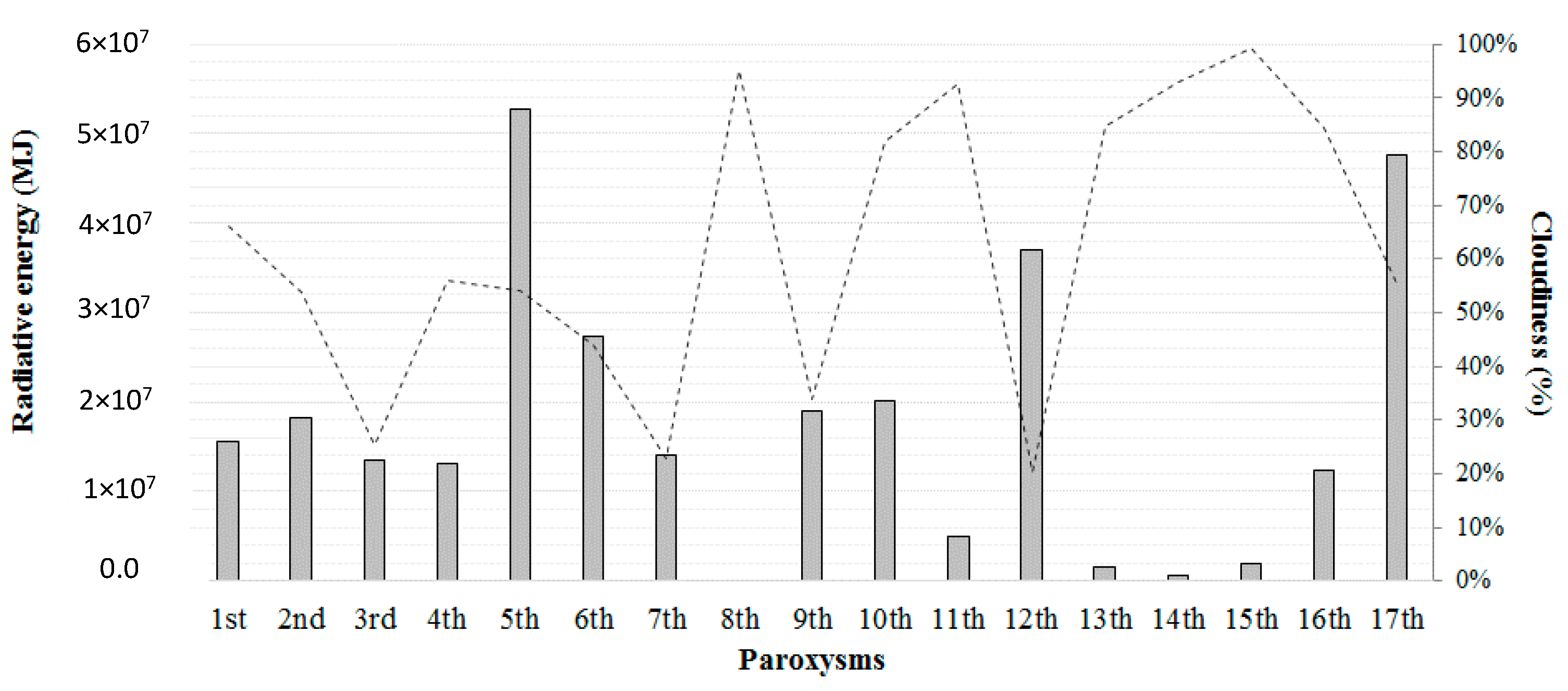

| Satellite | Sensor | Used Spectral Bands (Wavelength Range in µm) | Band Key Use | Spatial Resolution (Nadir) | Hotspot Detection Algorithm |
|---|---|---|---|---|---|
| Terra/Aqua | MODIS | 1 (0.620–0.670) 21/22 (3.929–3.989) 31 (10.780–11.280) 32 (11.770–12.270) | Cloud detection Hotspot detection Hotspot detection Cloud detection | 1 km | RSTVOLC |
| NOAA/MetOp | AVHRR | 1 (0.58–0.68) 3B (3.55–3.93) 4 (10.5–11.5) | Cloud detection Hotspot detection Cloud/hotspot detection | 1.1 km | RSTVOLC |
| MSG | SEVIRI | 1 (0.56–0.71) 4 (3.48–4.36) 9 (9.8–11.8) | Cloud detection Hotspot detection Cloud/hotspot detection | 3 km | RSTVOLC |
| Terra | ASTER | 12 (8.925–9.275) 13 (10.250–10.950) | Hotspot detection Cloud/hotspot detection | 90 m | RASTer |
| Landsat-8 | OLI | 5 (0.851–0.879) 6 (1.566–1.651) 7 (2.107–2.) | Hotspot detection | 30 m | NHI |
| Sentinel-2 | MSI | 8A (0.854–0.875) 11 (1.568–1.659) 12 (2.115–2.290) | Hotspot detection | 20 m | NHI |
Publisher’s Note: MDPI stays neutral with regard to jurisdictional claims in published maps and institutional affiliations. |
© 2021 by the authors. Licensee MDPI, Basel, Switzerland. This article is an open access article distributed under the terms and conditions of the Creative Commons Attribution (CC BY) license (https://creativecommons.org/licenses/by/4.0/).
Share and Cite
Marchese, F.; Filizzola, C.; Lacava, T.; Falconieri, A.; Faruolo, M.; Genzano, N.; Mazzeo, G.; Pietrapertosa, C.; Pergola, N.; Tramutoli, V.; et al. Mt. Etna Paroxysms of February–April 2021 Monitored and Quantified through a Multi-Platform Satellite Observing System. Remote Sens. 2021, 13, 3074. https://doi.org/10.3390/rs13163074
Marchese F, Filizzola C, Lacava T, Falconieri A, Faruolo M, Genzano N, Mazzeo G, Pietrapertosa C, Pergola N, Tramutoli V, et al. Mt. Etna Paroxysms of February–April 2021 Monitored and Quantified through a Multi-Platform Satellite Observing System. Remote Sensing. 2021; 13(16):3074. https://doi.org/10.3390/rs13163074
Chicago/Turabian StyleMarchese, Francesco, Carolina Filizzola, Teodosio Lacava, Alfredo Falconieri, Mariapia Faruolo, Nicola Genzano, Giuseppe Mazzeo, Carla Pietrapertosa, Nicola Pergola, Valerio Tramutoli, and et al. 2021. "Mt. Etna Paroxysms of February–April 2021 Monitored and Quantified through a Multi-Platform Satellite Observing System" Remote Sensing 13, no. 16: 3074. https://doi.org/10.3390/rs13163074
APA StyleMarchese, F., Filizzola, C., Lacava, T., Falconieri, A., Faruolo, M., Genzano, N., Mazzeo, G., Pietrapertosa, C., Pergola, N., Tramutoli, V., & Neri, M. (2021). Mt. Etna Paroxysms of February–April 2021 Monitored and Quantified through a Multi-Platform Satellite Observing System. Remote Sensing, 13(16), 3074. https://doi.org/10.3390/rs13163074











